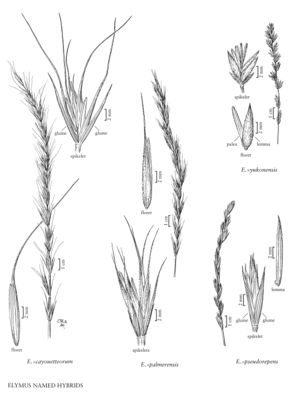Elymus ×pseudorepens
Plants rhizomatous. Culms 30-100 cm, ascending or erect, glabrous, mostly smooth, sometimes scabrous below the nodes. Leaves evenly distributed; sheaths glabrous; ligules to 0.5 mm; blades 10-25 cm long, 2-7 mm wide, involute when dry, both surfaces scabrous, adaxial surfaces sparsely pilose, hairs 0.7-1 mm. Spikes 5.5-13 cm long, 0.4-0.6 cm wide, with 1 spikelet per node; internodes 3.5-5 mm. Glumes 8-18 mm, equaling or exceeded by the adjacent lemmas, more or less flat, 5-9-veined, margins unequal, the wider margins to about 0.3 mm, narrowly acute, sometimes awned, awns to 1 mm; lemmas 7.5-15 mm, smooth and glabrous proximally, scabrous distally, mucronate or awned, awns to 3 mm; anthers 1.5-2 mm.
Distribution
Idaho, S.Dak., Wash., N.Mex., Utah, Wyo., Nebr., Mont., Nev., Ariz., Colo., Oreg., Alta., B.C., Man., Ont., Que., Sask.
Discussion
Elymus ×pseudorepens consists of hybrids between E. lanceolatus (p. 327) and E. trachycaulus (p. 321). It appears to be fairly common, having been reported from Alberta to Michigan and south to Arizona, New Mexico, and Arkansas.
Elymus ×pseudorepens is an Elymus named hybrid
Elymus is notorious for its ability to hybridize. Most of its interspecific hybrids are partially fertile, permitting introgression between the parents. The descriptions provided below are restricted to the named interspecific hybrids. They should be treated with caution and some skepticism; some are based solely on the type specimen, because little other reliably identified material was available. Moreover, as the descriptions of the non-hybrid species indicate, many other interspecific hybrids exist.
The parentage of all hybrids is best determined in the field. Perennial hybrids, such as those in Elymus, can persist in an area after one or both parents have died out, but the simplest assumption is that both are present. Interspecific hybrids of Elymus that have disarticulating rachises presumably have E. elymoides or E. multisetus as one of their parents.
Selected References
None.
Lower Taxa
"decumbent" is not a number.
